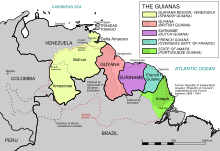Guiana Shield
Guiana Shield | |
|---|---|
 Political map of the Guiana Shield | |
| Coordinates: 5°08′36″N 60°45′45″W / 5.14333°N 60.76250°W | |
| Region | South America |



The Guiana Shield[1] (French: Plateau des Guyanes, Bouclier guyanais; Dutch: Hoogland van Guyana, Guianaschild; Portuguese: Planalto das Guianas, Escudo das Guianas; Spanish: Escudo guayanés) is one of the three cratons of the South American Plate. It is a 1.7 billion-year-old Precambrian geological formation in northeast South America that forms a portion of the northern coast.[2] The higher elevations on the shield are called the Guiana Highlands, which is where the table-like mountains called tepuis are found. The Guiana Highlands are also the source of some of the world's most well-known waterfalls such as Angel Falls, Kaieteur Falls and Cuquenan Falls.
The Guiana Shield underlies
Geology
The oldest rocks in the shield consist of
Geomorphology
There are three upland areas of the Guiana Shield:
- The state in Brazil.
- The Tumucumaque Uplands which are a series of central massifs in an arc from the Atlantic.
- The sediments of the Sub-Andean Trough that runs along the northern and western rim of the Guiana Shield.
The north-central part of the
Ecology

The Guiana Shield is one of the regions of highest biodiversity in the world, and has many endemic species. The region houses over 3000 vertebrate species: 1168 fresh water fish, 269 amphibians (54% endemics), 295 reptiles (29%), 1004 birds (7.7%), and 282 mammals (11%).[7][8][9] Diversity of invertebrates remains largely undocumented, but there are several species of endemic butterflies and dung beetles.[10][11]
Plant life is equally rich and 13,367 species of
According to recent researches, although ecosystems of the Guayana Highlands remain vibrant, emerging issues (including "a well-known invasive plant elsewhere" Poa annua and "one of the most aggressive weeds" Polypogon elongatus) and infectious faecal bacteria Helicobacter pylori have been documented.[15]
See also
- Gran Sabana – Region in southeastern Venezuela
- Tepui – Table-top mountain or mesa in the Guiana Highlands of South America
- Canadian Shield – Geographic and geologic area of North America
- Caribbean South America – Subregion of South America
- Mount Roraima – Mountain in Brazil, Guyana and Venezuela
- Pico da Neblina – Highest mountain in Brazil
- Great American Interchange – Paleozoographic event resulting from the formation of the Isthmus of Panama
- Geography of South America – Overview of the geography of South America
References
- ) which are on the Guiana Shield.
- ^ Hammond, David S. (ed.) (2005) Tropical Forests of the Guiana Shield CABI Publishing, Wallingford, UK, ISBN
- ^ Gibbs, A.K. and Barron,C.N. (eds) (1993) The Geology of the Guiana Shield Oxford University Press, Oxford, UK, ISBN
- ^ Geology and Mineral Resource Assessment of the Venezuelan Guayana Shield, USGS Bulletin 2062. US Government Printing Office. 1993. pp. 10–15.
- ISBN 9789048130542.
- ^ "Geociências: IBGE revê as altitudes de site Pontos culminates" [Geosciences: IBGE revises the altitude of seven high points] (Press release) (in Portuguese). Brasília: Brazilian Institute of Geography and Statistics (IBGE). 2016-02-29. Retrieved 2016-03-02.
- ^ Hollowell, T.; Reynolds, R.P. (2005). "Checklist of the Terrestrial Vertebrates of the Guiana Shield" (PDF). Bulletin of the Biological Society of Washington. 13.
- .
- ^ Vari, R.P.; Ferraris Jr., C.J.; Radosavljevic, A.; Funk, V.A. (2009). "Checklist of the freshwater fishes of the Guiana Shield" (PDF). Bulletin of the Biological Society of Washington. 17.
- S2CID 17263106.
- ^ Costa, Mauro; Viloria, Ángel L.; Hubber, Otto; Attal, Stéphane; Orellana, Andrés (2013). "Lepidoptera del Pantepui. Parte I: Endemismo y caracterización biogeográfica". Entomotropica. 28 (3): 193–217. Archived from the original on 27 August 2016. Retrieved 25 June 2016.
- ^ Funk, V.; Hollowell, T.; Berry, P.; Kelloff, C.; Alexander, S.N. (2007). "Checklist of the Plants of the Guiana Shield (Venezuela: Amazonas, Bolivar, Delta Amacuro; Guyana, Surinam, French Guiana)" (PDF). Contributions from the United States National Herbarium. 55.
- ^ Hammond, David S. (ed.) (2005) Tropical Forests of the Guiana Shield CABI Publishing, Wallingford, UK, ISBN
- ^ "Colombia | Ramsar".
- S2CID 23002053.
External links
 Media related to Guiana Shield at Wikimedia Commons
Media related to Guiana Shield at Wikimedia Commons Media related to Guiana Highlands at Wikimedia Commons
Media related to Guiana Highlands at Wikimedia Commons Media related to Tepuis at Wikimedia Commons
Media related to Tepuis at Wikimedia Commons

